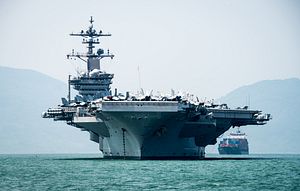Last week, the United States delivered another round of Metal Shark patrol vessels to Vietnam. Though the headlines focused on the development itself, its significance should be understood in the broader context of U.S.-Vietnam defense ties that have continued to deepen during the Trump administration despite lingering concerns.
As I have noted before, over the decades, United States and Vietnam defense cooperation has slowly grown to encompass areas including maritime security, humanitarian assistance and disaster relief, and peacekeeping (See: “US-Vietnam Defense Ties: Problems and Prospects”). That realm of the relationship deepened further under the Obama administration, with several steps taken though the focus is often on the historic lifting of a decades-old arms embargo towards the end of his tenure (See: “Why the Lifting of the US Arms Embargo to Vietnam Matters”).
The momentum has continued on under the Trump administration from the outset, and it has been across the board, from high-level visits to naval engagements to the handing over of vessels to Vietnam to boost its capabilities in the maritime security realm. Yet at the same time, this has coexisted with lingering concerns, both on specific bilateral ones like trade as well as some wider ones linked to the administration’s evolving Asia policy, including the Indo-Pacific vision which he had sketched out at Hanoi last year during the APEC Summit (See: “Trump’s Indo-Pacific Strategy Challenge”).
2018 has seen the momentum on defense ties continue, with new engagements and developments such as the visit of Defense Secretary Jim Mattis in January and the historic visit of the U.S. aircraft carrier Carl Vinson (See: “Why a First US Aircraft Carrier Vietnam Visit Matters”). And last week saw another one of these developments when the United States transferred six new Metal Shark boats to Vietnam.
To be sure, despite some of the sensationalist headlines, the Metal Shark commitment itself is far from new as it dates back to the Obama administration in June 2015, when it was publicly announced as part of former U.S. Defense Secretary Ash Carter’s trip there which also witnessed the inking of a new joint vision statement that outlined the future direction of the relationship. But continuing deliveries are nonetheless significant on its own terms given the capability boost for Vietnam’s military.
Beyond the development itself, it is also significant more broadly within the context of ongoing coast guard cooperation between the two countries. In part due to China’s growing assertiveness in the South China Sea, over the past few years, Vietnam has been empowering its developing coast guard forces to protect the country’s sovereignty, while the United States has been engaging a series of countries including Hanoi as part of an ongoing effort to deepen the U.S. Coast Guard’s role in the Asia-Pacific.
As this has occurred, we have seen both sides focus more on coast guard collaboration as part of their broader bilateral defense ties, buttressed by high-level visits including that of outgoing Coast Guard Commandant Admiral Paul Zukunft. As if to underscore this very point, the transfer of Metal Shark vessels, which occurred at Region 4 Station on Phu Quoc Island, came amid the inaugural visit of U.S. Coast Guard Commander Vice Admiral Fred M. Midgette to Vietnam.
The brisk pace of defense cooperation in 2018 has shown few signs of slowing down. Yet lest one gets carried away, there are no shortage of uncertainties and challenges for bilateral ties too. As I noted in an analysis of Mattis’ trip in January, these are not only rooted in unanswered questions about the Trump administration but deeper structural issues, including how Hanoi balances its ties with Washington with those of other major powers including China. That broader perspective is important to keep in mind when evaluating the significance of any single engagement in U.S.-Vietnam ties (See: “What Does Mattis’ ASEAN Trip Say About Trump’s Asia Policy?”).

































